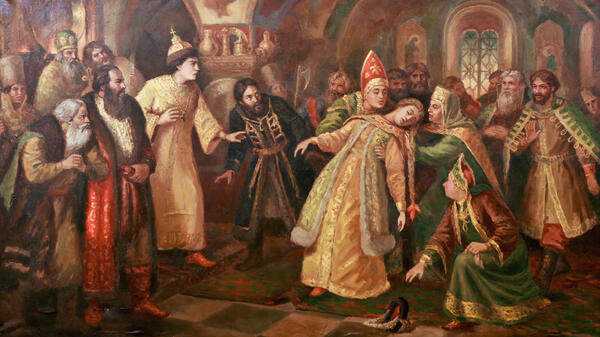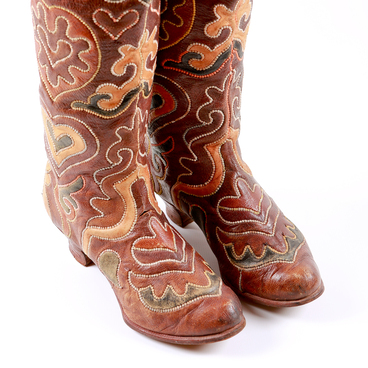The funds of the Kasimov Historical and Cultural Museum-Reserve contain several works by the Kasimov painter Alexey Leiben. He was a participant in the Great Patriotic War, after which he painted pictures, worked as an interior designer, decorator, and also illustrated books.
‘Kasimov Bride’ is one of the most grand-scale works by Alexey Leiben. It referred to the historical events of the mid–17th century when Tsar Alexei Mikhailovich Romanov was choosing a bride.
In 1647, 200 girls from different cities of the country were brought to Moscow for a bride show. At first, the court nobility selected those who could appear ‘before the bright eyes of the sovereign.’ The criteria were strict: the chosen one had to be ‘a woman of good height, full of beauty and intelligence’ as well as ‘give an heir to the tsar and the state.’
The court nobility selected only six girls — among them was a native of Kasimov, Euphemia Vsevolozhskaya, the daughter of a local army commander. The young tsar liked the girl at first sight, and he handed her a ring and a handkerchief embroidered with gold — as a souvenir. After that, Euphemia was sent to the women’s half of the house, where she had to learn court etiquette.
Not everyone in the palace approved of Alexei Mikhailovich’s choice. The tsar’s tutor, boyar Boris Morozov, wanted him to marry Maria Miloslavskaya. That way, he planned to become related to the Romanovs: Morozov himself wanted to marry her sister, Anna Miloslavskaya.
Therefore, when Euphemia fainted at a meeting with Alexei Mikhailovich, Morozov explained her indisposition with poor health: “Falling evil. Not strong enough for sovereign”s happiness.’ In the painting ‘Kasimov Bride’ Alexey Leiben depicted that moment: the bride in a yellow sundress lost her consciousness, her skin lost color. The court ladies who caught Euphemia tried to bring her to her senses.
Leiben painted about two dozen people on the canvas: the tsar, the bride, court nobility, and servants. The main figures — Alexei Mikhailovich and Euphemia — were highlighted by the artist with golden shades of paint, and for court nobility and servants he used darker tones.
For ‘Kasimov bride’ her fainting was a verdict: the family of Euphemia Vsevolozhskaya was sent into exile — to Tyumen, and the tsar held new bride show.
‘Kasimov Bride’ is one of the most grand-scale works by Alexey Leiben. It referred to the historical events of the mid–17th century when Tsar Alexei Mikhailovich Romanov was choosing a bride.
In 1647, 200 girls from different cities of the country were brought to Moscow for a bride show. At first, the court nobility selected those who could appear ‘before the bright eyes of the sovereign.’ The criteria were strict: the chosen one had to be ‘a woman of good height, full of beauty and intelligence’ as well as ‘give an heir to the tsar and the state.’
The court nobility selected only six girls — among them was a native of Kasimov, Euphemia Vsevolozhskaya, the daughter of a local army commander. The young tsar liked the girl at first sight, and he handed her a ring and a handkerchief embroidered with gold — as a souvenir. After that, Euphemia was sent to the women’s half of the house, where she had to learn court etiquette.
Not everyone in the palace approved of Alexei Mikhailovich’s choice. The tsar’s tutor, boyar Boris Morozov, wanted him to marry Maria Miloslavskaya. That way, he planned to become related to the Romanovs: Morozov himself wanted to marry her sister, Anna Miloslavskaya.
Therefore, when Euphemia fainted at a meeting with Alexei Mikhailovich, Morozov explained her indisposition with poor health: “Falling evil. Not strong enough for sovereign”s happiness.’ In the painting ‘Kasimov Bride’ Alexey Leiben depicted that moment: the bride in a yellow sundress lost her consciousness, her skin lost color. The court ladies who caught Euphemia tried to bring her to her senses.
Leiben painted about two dozen people on the canvas: the tsar, the bride, court nobility, and servants. The main figures — Alexei Mikhailovich and Euphemia — were highlighted by the artist with golden shades of paint, and for court nobility and servants he used darker tones.
For ‘Kasimov bride’ her fainting was a verdict: the family of Euphemia Vsevolozhskaya was sent into exile — to Tyumen, and the tsar held new bride show.



